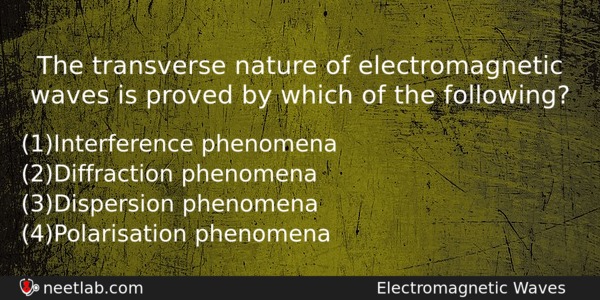| ⇦ | 
| ⇨ |
The transverse nature of electromagnetic waves is proved by which of the following?
Options
(a) Interference phenomena
(b) Diffraction phenomena
(c) Dispersion phenomena
(d) Polarisation phenomena
Correct Answer:
Polarisation phenomena
Explanation:
No explanation available. Be the first to write the explanation for this question by commenting below.
Related Questions: - The device can act as a complete electronic circuit is
- Activity of a radioactive sample decreases to (1/3)rd of its original value
- A perfect gas at 27° C is heated at constant pressure to 327° C. If original volume of gas
- A thermocouple is made from two metals, antimony and bismuth. If one junction
- A solid sphere is rotating in free space.If the radius of the sphere is increased
Topics: Electromagnetic Waves
(28)
Subject: Physics
(2479)
Important MCQs Based on Medical Entrance Examinations To Improve Your NEET Score
- The device can act as a complete electronic circuit is
- Activity of a radioactive sample decreases to (1/3)rd of its original value
- A perfect gas at 27° C is heated at constant pressure to 327° C. If original volume of gas
- A thermocouple is made from two metals, antimony and bismuth. If one junction
- A solid sphere is rotating in free space.If the radius of the sphere is increased
Topics: Electromagnetic Waves (28)
Subject: Physics (2479)
Important MCQs Based on Medical Entrance Examinations To Improve Your NEET Score
18000+ students are using NEETLab to improve their score. What about you?
Solve Previous Year MCQs, Mock Tests, Topicwise Practice Tests, Identify Weak Topics, Formula Flash cards and much more is available in NEETLab Android App to improve your NEET score.
Share this page with your friends

Leave a Reply